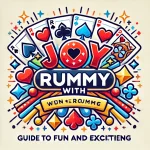
Rummy Gold 51: A Complete Guide to Mastering the Game Rummy Gold 51 is a powerful card game that has become very popular with players of all ages. Players find it to be an interesting hobby because it blends aspects of skill, strategy, and a little bit of luck. The goal of Rummy Gold 51, which is essentially a variation of traditional rummy, is to use the cards dealt to you to create legitimate sets and sequences. With the addition of jokers that can act as wildcards, the game usually consists of two to six players and a standard deck of cards.
For anyone wishing to start playing this thrilling game, it is imperative that they comprehend the fundamentals of Rummy Gold 51. The game begins with each player receiving a specific number of cards, usually 13, while the remaining cards form the draw pile. In order to create melds—combinations of three or more cards that are either in sequence or of the same rank—players alternately draw cards from the draw pile and the discard pile. The scoring mechanism of Rummy Gold 51 is distinctive in that it penalizes players for unmelded cards at the conclusion of each round and rewards them for creating melds.
This dynamic produces an atmosphere in which prompt decision-making and strategic thinking are essential for success. Players can start creating their own strategies & techniques to improve their gameplay as they get more comfortable with the game’s rules and flow. The key to succeeding in Rummy Gold 51 is having a winning mentality. While playing, this entails keeping a positive outlook, focusing, and being flexible in response to shifting conditions.
Players must go into every game with assurance, trusting that they can make wise choices based on their cards & their opponents’ moves. This mental toughness aids not only in strategic decision-making but also in handling the emotional turbulence that can come with competitive play. Players who maintain composure are better able to assess situations and produce better results.
Also, cultivating a winning mindset means taking lessons from both successes and setbacks. After every session, players should evaluate their performance because every game offers a chance for improvement. One can learn a lot about their playing style & decision-making processes by examining what went well and what didn’t.
Also, studying opponents can help you identify tactics that you can use or counter in subsequent games. Players can improve their overall performance in Rummy Gold 51 by cultivating a mindset that emphasizes resilience & constant improvement. Gaining proficiency in card counting.
Players who want to become proficient at card counting should establish a methodical way to keep track of cards during gameplay. This could entail mentally recording the ranks & suits of cards that have been dealt, or if permitted by house rules, writing down important details. analyzing the patterns of the opposition. Players should also keep an eye out for patterns in the way their opponents play, such as the cards they frequently pick up or discard.
Through the integration of this knowledge with their hand, players can acquire a tactical advantage that could result in more prosperous rounds. Strategic Choice-Making. This knowledge can be useful in anticipating possible melds from opponents & modifying one’s approach appropriately. Players can improve their odds of winning by well-informedly choosing which cards to keep or discard.
Rummy Gold 51 is all about building melds and sets, and having good strategies in place can significantly increase a player’s chances of winning. Prioritizing the formation of sequences over sets whenever feasible is one basic strategy. Usually simpler to finish than sets of three or four cards of the same rank, sequences are made up of three or more consecutive cards of the same suit. Players can increase the flexibility of their combinations and increase their adaptability as new cards are drawn by concentrating on sequences. Holding onto high-value cards until they can be combined to form a set or sequence is another successful tactic.
Early discarding of high-value cards may be alluring, but if players are unable to form valid melds by the end of the round, they may be subject to penalties. Rather, players ought to evaluate their hand on a regular basis and think about how they can best use these valuable cards in combination with other cards they draw during the game. With this strategic approach, risk is reduced while potential points are maximized.
A key component of Rummy Gold 51 that calls for careful thought and strategy is discarding. In order to maximize their own hand and reduce their opponents’ chances of creating melds, players must find a balance. A crucial piece of advice is to observe which cards your opponents are selecting from the discard pile. An opponent may be on the verge of integrating those cards into a meld if they routinely pick up particular ranks or suits.
It might be prudent in these situations to keep cards that could help them from being thrown out. Players should also think about their hand’s overall composition when choosing which cards to discard. It might be advantageous for a player to discard their cards first if they are not contributing to any possible melds. But it’s important to maintain flexibility; players should regularly review their hands and modify their discarding strategy in light of new cards being drawn.
Players can increase their chances of winning by making more strategic discards while keeping in mind both their own and their opponents’ needs. Jokers & wild cards are essential in Rummy Gold 51 because they give players special chances to finish sets and melds. These adaptable cards are extremely valuable assets during gameplay because they can be used in place of any other card to form valid combinations. Players should try to use jokers in their hardest melds first, ones that would be hard to finish without them, in order to make the most of them. A player’s hand can be strengthened by this tactical application, which also keeps opponents off-balance regarding their possible moves.
But it’s equally critical to exercise caution when it comes to the number of jokers being held onto at any one time. Jokers can greatly improve a hand, but if the round ends without declaring, keeping too many of them without creating melds can result in penalties. Before declaring their hand, players should make sure they have enough valid melds formed and use jokers strategically. Players can significantly outperform their rivals by becoming proficient in the art of using jokers. One of the most important Rummy Gold 51 strategies is knowing when to declare, which frequently makes the difference between winning and losing.
If a player makes a declaration too soon, they may not have enough valid melds to protect themselves, and if they wait too long, they may lose out on opportunities as opponents get closer to their own declarations. Declaring when you have at least two or three strong melds formed, along with a few extra cards that are simple to incorporate into new melds, is a good general rule. When choosing whether to declare, players should also take the current state of play into account. It could be prudent to declare sooner rather than later if opponents seem to be getting close to finishing their hands or if they have been regularly selecting particular cards from the discard pile.
On the other hand, it could be advantageous for a player to wait to declare until they can further increase their score if they have a strong hand but observe that opponents are having trouble with theirs. By being aware of these subtleties in gameplay, players will be better equipped to decide when to declare. As players gain more Rummy Gold 51 experience, they might want to investigate more sophisticated strategies that can improve their performance even more.
Bluffing, which is the deliberate discarding of cards that could give opponents false information about one’s true intentions or hand composition, is one such tactic. Players may cause confusion & mislead opponents about their own strategies if they discard a card that could potentially complete an opponent’s meld while keeping other valuable cards. Gaining an intuitive understanding of how opponents behave and pattern throughout the game is another sophisticated tactic. This involves counting the speed at which they remove particular cards from the discard pile or the frequency with which they alter their approach in response to what other players are doing.
Players can anticipate their opponents’ moves and modify their strategies accordingly by developing this skill, which can be used to block possible melds or take advantage of gameplay flaws. In addition to improving individual performance, mastering these sophisticated strategies gives Rummy Gold 51 an intriguing new level of complexity. In summary, Rummy Gold 51 calls for deft strategy, psychological awareness, and flexibility; it is not merely a game of chance.
Players can greatly increase their chances of success in this captivating card game by comprehending its basics, cultivating a winning mindset, learning card counting strategies, creating strong melds, discarding prudently, strategically using jokers, identifying the best times to declare, & using sophisticated strategies. These tips will improve any player’s Rummy Gold 51 experience, whether they are playing competitively in tournaments or just for fun with friends.




